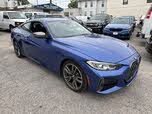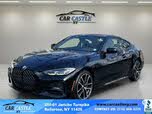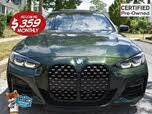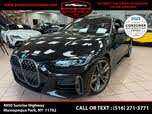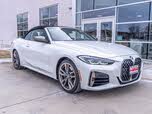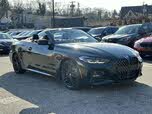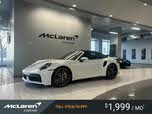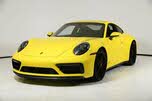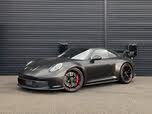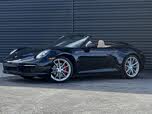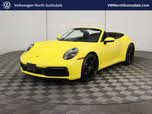2021 BMW 4 Series vs 2022 Porsche 911
Overview | ||
MSRP | $45,600 | $101,200 |
Average price | $35,293 | $189,675 |
Listings | ||
Ratings & Reviews | ||
User reviews | ||
Expert reviews | 6.8 out of 10Read full review | 7.7 out of 10Read full review |
Pros & cons | Pros
| Pros
|
Summary | The 2021 BMW 4 Series represents how, for better or worse, BMW has changed. The 4 Series name has been around since the 2014 model year when it was introduced for the former 3 Series coupe and convertible. Earlier two-door 3 Series models built BMW’s reputation, with excellent handling, smooth yet powerful engines, and understated styling. The redesigned second-generation 4 Series departs dramatically from that template. It’s bigger and more luxurious, with garish styling and a greater reliance on technology for performance. The car’s rivals haven’t changed though. It still competes against the Audi A5, Mercedes-Benz C-Class, Lexus RC, and Infiniti Q60 for buyers willing to sacrifice a bit of practicality to make a fashion statement. As before, the 4 Series is available in coupe and convertible body styles—the latter with a soft-top instead of the previous retractable hardtop. Both body styles are offered in four-cylinder 430i and six-cylinder M440i configurations, with high-performance M4 variants on the way. Rear-wheel drive is standard, with xDrive all-wheel drive optional (and mandatory on the M440i coupe). Our test car was a 430i xDrive coupe. | The Porsche 911 has been the go-to sports car for over 50 years, and for good reason. Its focus on performance has incrementally improved every aspect of this small coupe over the generations. At the same time, that performance is easily approachable and doesn’t get in the way of everyday drivability. |
Video | No video found | |
Popular Features & Specs | ||
Engine | 2.0L 255 hp I4 | 3.0L 379 hp H6 |
Drive Train | RWD | RWD |
Seating Capacity | 4 | 4 |
Horsepower | 255 hp @ 5000 rpm | 379 hp @ 6500 rpm |
MPG City | 26 | 18 |
MPG Highway | 34 | 24 |
Engine | ||
Engine Name | 2.0L 255 hp I4 | 3.0L 379 hp H6 |
Torque | 294 lb-ft @ 1550 rpm | 331 lb-ft @ 1950 rpm |
Horsepower | 255 hp @ 5000 rpm | 379 hp @ 6500 rpm |
Drivetrain | RWD | RWD |
Fuel Economy | ||
MPG City | 26 | 18 |
MPG Highway | 34 | 24 |
Interior | ||
Seating Capacity | 4 | 4 |
Key Features | ||
Navigation System | Standard | Standard |
Sunroof/Moonroof | Standard | |
Dimensions & Capacity | ||
Cargo Space | 15.5 cu ft | 4.6 cu ft |
Curb Weight | 3578 lbs | 3354 lbs |
Height | 54.6 in | 51.1 in |
Length | 187.9 in | 177.9 in |
Width | 81.9 in | 79.7 in |
Wheelbase | 112.2 in | 96.5 in |
Maximum Payload | 714 lbs | 967 lbs |
Number of doors | 2 | 2 |
The 2021 BMW 4 Series coupe's styling was dominated by its massive new twin-kidney grille, which BMW claimed improved engine cooling. While beauty is subjective, it was challenging to find anyone who found it attractive. The rest of the car adhered to standard BMW styling, featuring LED headlights and taillights, and a familiar overall shape. Despite its controversial front end, the car boasted a drag coefficient of 0.25, thanks to aerodynamic features like Air Curtain intakes. The 4 Series shared its platform with the BMW 3 Series sedan, but was slightly longer, wider, and lower, with a wider rear track. The interior followed BMW's clean and uncluttered design, with standard front sport seats offering 10-way power adjustment and driver’s memory. However, the materials, while decent, fell short of true luxury standards. The sportier feel was enhanced by standard paddle shifters and a leather-wrapped “sport” steering wheel, though the latter's size felt more appropriate for a bus than a sporty coupe.
The 2022 Porsche 911 retained its iconic rear-engine layout and styling, evolving gradually since its 1963 debut. Known as a "driver's car," the 911 prioritized performance, making some sacrifices for athleticism. Despite this, most 911 models were relatively comfortable for daily driving. The 911's sturdy build quality and refined interior helped justify its high price. With the automotive industry's shift towards electrification, the future of the 911's internal-combustion engine was uncertain. The next-generation Porsche Boxster and Cayman were set to be electrified, and the success of the Taycan electric sedan hinted at a promising future for a potential 911 EV.
The 2021 BMW 4 Series offered two powertrains. The 430i model featured a 2.0-liter turbocharged four-cylinder engine, producing 255 horsepower and 294 pound-feet of torque. The M440i was powered by a 3.0-liter turbocharged inline-six, delivering 382 hp and 369 lb-ft of torque, with a 48-volt starter/generator for better fuel efficiency. Both models came with an eight-speed automatic transmission. The 430i coupe could accelerate from 0 to 60 mph in 5.5 seconds, while the AWD 430i xDrive shaved 0.2 seconds off that time. The M440i xDrive coupe reached 60 mph in 4.3 seconds. However, the real-world driving experience was hampered by a hesitant transmission and uninspiring engine sound. The optional Adaptive M Suspension and other performance upgrades provided a composed chassis and plenty of grip, but the steering lacked precision, and the overall driving experience was underwhelming.
The 2022 Porsche 911's engine was as iconic as the car itself, featuring a horizontally-opposed six-cylinder "boxer" engine mounted behind the rear axle. This layout favored high-performance driving, making the car more responsive and capable of rotating its tail into turns. The 911 lineup included 10 variants, with the base Carrera's 3.0-liter turbocharged boxer-six producing 379 horsepower. The Carrera 4 featured AWD, while the Carrera S increased output to 443 hp. The new 473-hp GTS represented a middle ground between the Carreras and higher-performing models like the Turbo, Turbo S, GT3, and GT3 Touring. The 911 offered an eight-speed dual-clutch transmission (PDK) and a seven-speed manual gearbox on S and GTS models. The PDK improved acceleration and fuel efficiency, while the manual provided more engagement. The Carrera GTS Cabriolet test vehicle, with the PDK transmission, reached 60 mph in 3.4 seconds and had a top speed of 192 mph. The 911's handling was precise, with adjustable suspension settings and effective brakes, making it an accomplished sports car with minimal sacrifices to drivability, comfort, and refinement.
The 2021 BMW 4 Series offered reasonable practicality for a coupe, with more front headroom and trunk space than competitors like the Audi A5, Infiniti Q60, Lexus RC, and Mercedes-Benz C-Class coupes. However, it lagged in legroom and rear headroom compared to some rivals. The rear seats were suitable for children or occasional adult use. The front-seat space was adequate, making it a good choice for those who found two-seat sports cars too cramped. The cockpit was logically laid out, with an integrated infotainment touchscreen, convenient cubbyholes, and excellent outward visibility.
The 2022 Porsche 911's interior blended historic personality with modern sensibilities. The design featured a large analog tachometer flanked by smaller digital gauges and a 10.9-inch infotainment touchscreen. The standard seats were comfortable and supportive, with optional sport seats providing improved lateral support. The rear seats were small and better suited for cargo overflow, as the front trunk offered only 4.6 cubic feet of space. Interior storage was limited, with small door pockets and a shallow armrest bin. The convertible's fabric top could be stowed or deployed in 12 seconds, with excellent wind noise reduction. The 911's interior featured excellent materials and sturdy construction, with options to add color and customization, though Porsche options were notoriously expensive.
The 2021 BMW 4 Series came with the standard BMW iDrive 7 infotainment system, featuring an 8.8-inch touchscreen and a 5.1-inch display screen in the instrument cluster. The optional Live Cockpit Professional setup included a 10.25-inch central touchscreen and a 12.3-inch all-digital instrument cluster. The test car had Live Cockpit Professional, with well-designed graphics and menus. The iDrive rotary controller provided a tactile response, making navigation easy. Standard features included wireless Apple CarPlay and Android Auto compatibility, Bluetooth, and SiriusXM satellite radio. A head-up display and wireless phone charging were available at extra cost.
The 2022 Porsche 911 prioritized driving experience over technology. The infotainment system's touchscreen was mounted lower, requiring drivers to take their eyes off the road. Apple CarPlay was wireless, but Android Auto required a USB cable. The base audio system was underwhelming, with the optional Bose system being a recommended upgrade. The premium audio system was expensive but justified for audiophiles. Remote Park Assist was available as part of the Premium package. The 911's drive systems featured various modes, including Comfort and Sport Plus, which altered the car's character and performance.
The 2021 BMW 4 Series had not yet been rated by the National Highway Traffic Safety Administration (NHTSA) or the Insurance Institute for Highway Safety (IIHS). Standard driver-assist features included lane-departure warning, forward-collision warning, automatic emergency braking, blind-spot monitoring, rear cross-traffic alert, automatic high beams, and speed-limit information. Adaptive cruise control was available as part of the $1,700 Driving Assistance Professional Package, which included a sophisticated system with stop-and-go capability and steering assist.
The 2022 Porsche 911 had not been evaluated by the NHTSA or IIHS, which was typical for high-end luxury vehicles. Standard safety features on the base Carrera included forward-collision warning with automatic emergency braking and lane-keep assist. The optional Premium package added adaptive headlights, a surround-view camera system, and blind-spot monitoring. Other options included night vision and an integrated dashcam feature. The 911 offered fewer safety features compared to conventional sedans and SUVs, but this was typical for sports cars.
CarGurus highlights

According to CarGurus experts, the overall rating for the 2021 BMW 4 Series is 6.8 out of 10, while the 2022 Porsche 911 scores 7.7 out of 10. Based on these ratings, the 2022 Porsche 911 is the recommended choice for those seeking a high-performance sports car with a rich heritage, excellent build quality, and a driver-focused experience.
Choose the 2021 BMW 4 Series if:
Shop Now- You prioritize front headroom and trunk space in a coupe.
- You prefer a logically laid-out cockpit with excellent outward visibility.
- You want a car with a clean and uncluttered interior design.
Choose the 2022 Porsche 911 if:
Shop Now- You seek a high-performance sports car with a rich heritage and iconic styling.
- You value a driver-focused interior with excellent materials and sturdy construction.
- You desire a convertible with a quick and efficient fabric top.

By: CarGurus + AI
At CarGurus, our team of experienced automotive writers remain at the heart of our content operation, conducting hands-on car tests and writing insightful guides that are backed by years of industry experience. To complement this, we are harnessing AI to make our content offering more diverse and more helpful to shoppers than ever. To achieve this, our AI systems are based exclusively on CarGurus content, ratings and data, so that what we produce is both unique to CarGurus, and uniquely helpful to car shoppers.


















